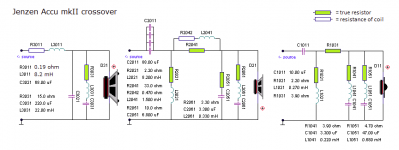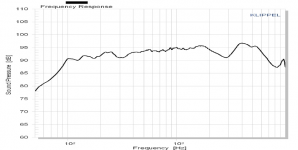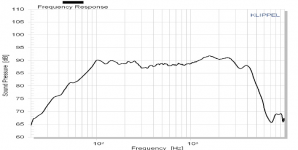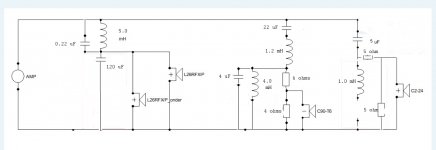Your midrange is large with a hard cone that strongly resonates at 5-6kHz. If you drive this resonance the sound will be less than good. This typically involves using steep low pass filters on the midrange, a notch or two at the resonance frequencies and crossing at less than 1/3rd of the lowest resonant frequency so that the 3rd harmonic of the motor does not drive the resonance. After a brief glance, your tweeter looks large enough to be able to cross low enough so things look tight but doable.Or maybe suggestions.
For many the hobby involves messing about having some fun and discovering things such as implementing different crossovers and listening to the results. I would suggest adding a conventional crossover of the kind outlined above to your list of crossovers to try.
I`m now joined the PE Tech talk , but cant figure out how can I post on this site. I have to wait I suppose.
PE seem to have a new format ( unless my phone is making it look different)
Give it a couple of days after registering and you shd be able to start a new thread. You'll soon get to know the regular posters there, v keen to offer advice without putting you down like a few on here lol
OMG, look at these drivers! 
ACCUTON C173-6-090
ACCUTON C30-6-023 (C23-6)
Seas L26RFX/P
Just the H1209-08 L26RFX/P fills me with horror. Rings like a bell at 4kHz.
Not for simple crossovers, though a 4kHz notch wouldn't be hard. In fact something like it is in the schema. I can't imagine what a 100K resistor is doing here though.
ACCUTON C173-6-090
ACCUTON C30-6-023 (C23-6)
Seas L26RFX/P
Just the H1209-08 L26RFX/P fills me with horror. Rings like a bell at 4kHz.
Not for simple crossovers, though a 4kHz notch wouldn't be hard. In fact something like it is in the schema. I can't imagine what a 100K resistor is doing here though.
An externally hosted image should be here but it was not working when we last tested it.
Last edited:
The hard woofer cone does not look much of an issue given the use of an overly large midrange and lots of room to manoeuvre. The overly large hard midrange cone on the other hand is a problem if you don't want to listen to it resonating and/or an overly stretched tweeter.OMG, look at these drivers!
ACCUTON C173-6-090
ACCUTON C30-6-023 (C23-6)
Seas L26RFX/P
Just the H1209-08 L26RFX/P fills me with horror. Rings like a bell at 4kHz.
It will be interesting to see if the OP sticks with "audiophile" crossovers and components or moves towards a better engineered solution as his experience grows. He currently seems enthusiastic and "audiophile" orientated so I guess he will first need to become dissatisfied based on his findings before possibly looking for an alternative approach. Or, of course, he might give up in disgust like the chap recently and his Wilmslow Audio speaker with very expensive drivers and a very bad crossover. Interesting stuff.
Why might it be popular to drive the resonance of an extremely expensive driver which is when the damping would make a significant difference? Wouldn't you expect most designs that are using very expensive drivers to keep them within the high performance part of their operating range? In which case the damping is unlikely to matter much.Never understood why Accuton didn't use their damping cut outs on a C158 size midbass. I'm sure it could have been popular
Perhaps I am wrong and most designs using Accuton drivers have chosen them on price and not because they are a good fit for the design. I must confess this is the first time I have glanced at them in any sort of detail having dismissed them in the past as irrelevant because of the price.
Why might it be popular to drive the resonance of an extremely expensive driver which is when the damping would make a significant difference?
Sorry didn't understand this part.
Damping reduces the magnitude of resonances. If you don't drive the resonances then damping becomes unimportant. The classic example of this is perhaps subwoofer cabinets which can baffle some by not being damped.Sorry didn't understand this part.
In the case of a driver with a hard cone the only high performance approach I am aware of is to avoid driving the resonance. If you are paying a lot of money for the driver it makes even less sense to then drive the resonances (as the OP is currently doing) to give a worse performance than a modestly priced driver would give when operated within the linear part of its operating range.
If you avoid driving the resonances then it will have little effect but if you drive the resonances then it will beneficial. The pads are also likely to change the stiffness, symmetry of the cone motion, etc... so it may be unwise to make too strong a statement.So reducing cone break up with cut outs just above crossover point is pointless then
But why opt for a very expensive driver with a hard cone and then drive the cone break up resonances whether damped or not? This is playing to the disadvantages of hard cone drivers not their advantages. If the speaker design makes this unavoidable then a strongly damped softer cone is almost sure to be a better choice in terms of sound quality.
I must be bored, but I was looking at this speaker today:
H1209-08 L26RFX/P
accuton® Carefully selected loudspeaker drivers.
accuton® Carefully selected loudspeaker drivers.
I always need a point of departure when thinking about a design. Troels Gravesen used this tweeter in an LR2 time-aligned 3 way. His 2.3kHz tweeter filter is what I would build around. The 4kHz notch on the metal bass here is straightforward.
Jenzen-Accu
The mid is the considerably easier Accuton C173-6-191E, which rolls off nicely at 3kHz.
I don't suppose it's too hard to adapt that design for the much broader bandwidth Accuton C173-6-090. But that dip at 3kHz is problematic, and the subsequent peak needs treatment, as is phase on the tweeter. You'd think matching polarity on the mid and tweeter, being flat baffle. And because this midbass is so efficient, an attenuator loses most of the possible impedance problems.
An externally hosted image should be here but it was not working when we last tested it.
H1209-08 L26RFX/P
accuton® Carefully selected loudspeaker drivers.
accuton® Carefully selected loudspeaker drivers.
I always need a point of departure when thinking about a design. Troels Gravesen used this tweeter in an LR2 time-aligned 3 way. His 2.3kHz tweeter filter is what I would build around. The 4kHz notch on the metal bass here is straightforward.
Jenzen-Accu
The mid is the considerably easier Accuton C173-6-191E, which rolls off nicely at 3kHz.
I don't suppose it's too hard to adapt that design for the much broader bandwidth Accuton C173-6-090. But that dip at 3kHz is problematic, and the subsequent peak needs treatment, as is phase on the tweeter. You'd think matching polarity on the mid and tweeter, being flat baffle. And because this midbass is so efficient, an attenuator loses most of the possible impedance problems.
An externally hosted image should be here but it was not working when we last tested it.
Attachments
I've been mulling this one over. That Troel's Jenzen Accu C173-6-191E midrange is not hard to change here: accuton® Carefully selected loudspeaker drivers.
I just looked at the HF rolloff and thought, it's like a higher inductance version of the C173-6-090. And it is! Le of 0.7mH instead of 0.19mH. The rest, as they say, is just technique.
I just looked at the HF rolloff and thought, it's like a higher inductance version of the C173-6-090. And it is! Le of 0.7mH instead of 0.19mH. The rest, as they say, is just technique.
Attachments
Hi Steve,
Thank you for all the effort . I saw this Janzen Diamond by research in Google for the C30-6-24 crossover some days ago. And came to that if could be suitable for my Tweeter and Mids. With only adjustments in series resistor for the Midds because of the efficiency of this 173-6-90 and also the breaking point on the lower frequencies by make 88uF to 94uF. And on tweeter remove the resistor R1031?!
And can i leave my Bass XO section unchanged ?!
This updated Xo looks nowadays like this:

There are only a few changes to the crossover compared to first launch. Middriver's notch-filter has been fine-tuned at little by the 0.33 mH coil. Tweeter circuit is basically the same, only C1011 is reduced to 8.2 uF and the notch filter has been further improved to provide a smooth reponse roll-off towards lower frequences. Point of crossover has moved up some 200-300 Hz, now around 2.5 kHz. For tweeter attenuation R1031 can take any value from 3R9 to 5R6. My default is 4R7. It depends on associated gear, listening distance, overall room acoustics and not least taste. 3R9 gives tremendous detail but may turn harsh on certain recordings. Don't forget the bass notch-filter. R3031 can be changed from 15 ohms to 33 ohms - or the circuit can be left out.
And don't think there is one final truth to the crossover as can be seen below, but we have to be able to follow what is happening by simulation, measurements - and the ear.
It’s a great news that I have no that hard way to re-design my XO after all. I have I think very Hi-End components to make this kind of 2nd order XO. Maybe I have to buy some resistors and inductors. But his will be not a problem I think.
First what I’m willing to test is to put a zobel on tweeter 1uF and 6.8 Ohm and add my new 50uF Duelund Cast capacitor on the mids. Everything on 1st order concept.
What stroke me that some Zobel Networks are connected first from plus pole by capacitors and then with resistors to minus , and on some XO design are first plus pole connected to resistor and then to capacitor. How come ?
Thank you for all the effort . I saw this Janzen Diamond by research in Google for the C30-6-24 crossover some days ago. And came to that if could be suitable for my Tweeter and Mids. With only adjustments in series resistor for the Midds because of the efficiency of this 173-6-90 and also the breaking point on the lower frequencies by make 88uF to 94uF. And on tweeter remove the resistor R1031?!
And can i leave my Bass XO section unchanged ?!
This updated Xo looks nowadays like this:

There are only a few changes to the crossover compared to first launch. Middriver's notch-filter has been fine-tuned at little by the 0.33 mH coil. Tweeter circuit is basically the same, only C1011 is reduced to 8.2 uF and the notch filter has been further improved to provide a smooth reponse roll-off towards lower frequences. Point of crossover has moved up some 200-300 Hz, now around 2.5 kHz. For tweeter attenuation R1031 can take any value from 3R9 to 5R6. My default is 4R7. It depends on associated gear, listening distance, overall room acoustics and not least taste. 3R9 gives tremendous detail but may turn harsh on certain recordings. Don't forget the bass notch-filter. R3031 can be changed from 15 ohms to 33 ohms - or the circuit can be left out.
And don't think there is one final truth to the crossover as can be seen below, but we have to be able to follow what is happening by simulation, measurements - and the ear.
It’s a great news that I have no that hard way to re-design my XO after all. I have I think very Hi-End components to make this kind of 2nd order XO. Maybe I have to buy some resistors and inductors. But his will be not a problem I think.
First what I’m willing to test is to put a zobel on tweeter 1uF and 6.8 Ohm and add my new 50uF Duelund Cast capacitor on the mids. Everything on 1st order concept.
What stroke me that some Zobel Networks are connected first from plus pole by capacitors and then with resistors to minus , and on some XO design are first plus pole connected to resistor and then to capacitor. How come ?
Last edited:
I wouldn't say this is going to be easy at all. 
But we might take something away from Troels here:
Jenzen-Accu
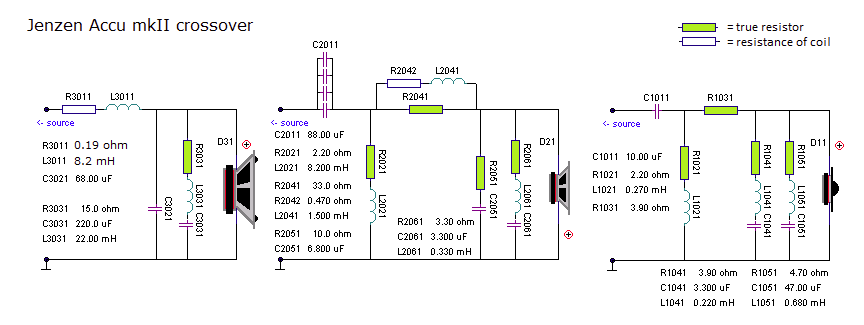
Sorry to leech your bandwidth, Mr. Troels, BTW... I have to work with what I'm given.
Jenzen-Diamond

This is an LR2 second order approach. The second one uses an entirely different tweeter, so we must be careful with tweeter Fs correction. But my feeling is that adding 0.5mH to the series mid coil will largely do the trick.
BTW, the order of shunt components like in Zobels makes no difference in theory. At least at audio frequencies. And the bass filter will be entirely different for your metal cones.
But we might take something away from Troels here:
Jenzen-Accu

Sorry to leech your bandwidth, Mr. Troels, BTW... I have to work with what I'm given.
Jenzen-Diamond

This is an LR2 second order approach. The second one uses an entirely different tweeter, so we must be careful with tweeter Fs correction. But my feeling is that adding 0.5mH to the series mid coil will largely do the trick.
BTW, the order of shunt components like in Zobels makes no difference in theory. At least at audio frequencies. And the bass filter will be entirely different for your metal cones.
Last edited:
Steve, and I was already celebrating the success 
I must say I do not understand the XO – designing. You advise me that add 0.5mH to series Mids (L2041 ) making it 2.0mH will do the trick. I have now 0.5mH in te mids. Strange that the 1st order XO is that different from the 2nd order on that inductor.
Further I have to leave the L-Pad on my Mids and remove the (R1031) from tweeter ? And i`m good for testing ?
The components that are in series will be high-end components , and Zobel networks , but the rest isn’t that important of I’m wrong ? And if so what are the parallel imported parts in this Janzen Accu mkII crossover ?
I must say I do not understand the XO – designing. You advise me that add 0.5mH to series Mids (L2041 ) making it 2.0mH will do the trick. I have now 0.5mH in te mids. Strange that the 1st order XO is that different from the 2nd order on that inductor.
Further I have to leave the L-Pad on my Mids and remove the (R1031) from tweeter ? And i`m good for testing ?
The components that are in series will be high-end components , and Zobel networks , but the rest isn’t that important of I’m wrong ? And if so what are the parallel imported parts in this Janzen Accu mkII crossover ?
Last edited:
Hotel guys. From another forum i got a 2nd XO that may work with my project.
Here's my XO suggestion -
2nd order HP w/L-pad: 5uF series cap, 1.0mH shunt coil (higher DCR OK), L-pad: series 5ohms, parallel 5ohms
2nd order BandPass w/"L": 1.2mH series coil, 22uF series cap, (2 shunts) 4uF cap, also - 4.0mH shunt coil, L-pad: SR = 6ohms, PR = 4ohms
"tanked" 2nd order LP for parallelled Seas woofers: 5mH low DCR series coil, 120uF shunt cap, a teeny 0.22uF (notch) cap needs to parallel the 5.0mH series coil.
Fcs near 450Hz and 2.3kHz. Normally, only the mid would be connected reverse polarity.
Here's my XO suggestion -
2nd order HP w/L-pad: 5uF series cap, 1.0mH shunt coil (higher DCR OK), L-pad: series 5ohms, parallel 5ohms
2nd order BandPass w/"L": 1.2mH series coil, 22uF series cap, (2 shunts) 4uF cap, also - 4.0mH shunt coil, L-pad: SR = 6ohms, PR = 4ohms
"tanked" 2nd order LP for parallelled Seas woofers: 5mH low DCR series coil, 120uF shunt cap, a teeny 0.22uF (notch) cap needs to parallel the 5.0mH series coil.
Fcs near 450Hz and 2.3kHz. Normally, only the mid would be connected reverse polarity.
Attachments
- Status
- This old topic is closed. If you want to reopen this topic, contact a moderator using the "Report Post" button.
- Home
- Loudspeakers
- Multi-Way
- My New Concept
